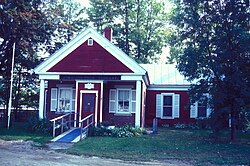Norridgewock, Maine
| Norridgewock, Maine | |
|---|---|
| Town | |

Old Norridgewock Library
|
|
| Country | United States |
| State | Maine |
| County | Somerset County |
| Area | |
| • Total | 51.21 sq mi (132.63 km2) |
| • Land | 49.95 sq mi (129.37 km2) |
| • Water | 1.26 sq mi (3.26 km2) |
| Population (2010) | |
| • Total | 3,367 |
| • Estimate (2012) | 3,354 |
| • Density | 67.4/sq mi (26.0/km2) |
| Time zone | Eastern (EST) (UTC-5) |
| • Summer (DST) | EDT (UTC-4) |
Norridgewock is a town in Somerset County, Maine, United States. The population was 3,367 at the 2010 census.
Situated on the New England and Acadia border, which New France defined as the Kennebec River, the area was once territory of the Norridgewock Indians, a band of the Abenaki nation. Their village was located at Old Point, now part of Madison.
English colonists suspected Father Sebastien Rale (or Rasle), the French missionary at the village since 1694, of abetting tribal hostilities against British settlements during the French and Indian Wars. During Father Rale's War, soldiers left Fort Richmond (now Richmond) in whaleboats until they reached Taconic Falls (now Winslow), then marched quietly to Norridgewock Village, arriving on August 23, 1724. Battle of Norridgewock was "sharp, short and decisive," leaving 26 warriors slain, 14 wounded and 150 survivors fleeing to Quebec, Canada. Father Rale was among the dead.
The British settled the area in 1773, then called Norridgewock Plantation. In 1775, Benedict Arnold and his troops marched through on their way to the Battle of Quebec.
The town was incorporated on June 18, 1788. It became county seat of Somerset County in 1809, with a courthouse built in 1820 and remodeled in 1847, although the county seat would be moved to Skowhegan in 1871. Wooden logs were floated down the Kennebec River. A sawmill was built to manufacture the region's abundant hardwoods, used in local factories to make carriages and furniture. Norridgewock also had a gristmill and granite works. Built in 1849 and replaced in 1929, the 600-foot (180 m) Norridgewock Covered Bridge across the Kennebec River was the second longest covered bridge in Maine after the 792-foot (241 m) Bangor Covered Bridge, which was built in 1846 across the Penobscot River to Brewer. The Eaton School was organized by Hamlin F. Eaton in 1856 and incorporated in 1874 "...for the promotion of literature, science and morality." Its Second Empire building, designed by architect Charles F. Douglas of Lewiston, later became Somerset Grange #18. In 1988, it was listed on the National Register of Historic Places.
...
Wikipedia
